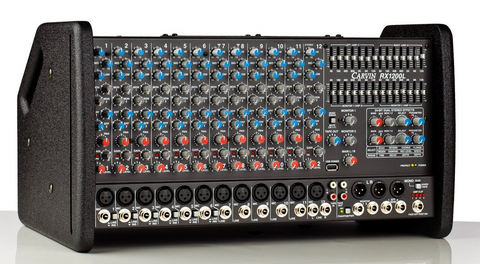-
Audio
-
Guitar
-
Bass
-
Blog
-
SALE
- Financing
- Support
- SINCE 1946
December 21, 2016

A good mixer is an essential component of a live show. Even though the band and audience members alike may go the whole night without even seeing the mixer, this little piece of equipment has a big role in providing the best possible sound to the stage and the house.
What a Mixer Does
The mixer’s job is basically to take all the audio elements of a band and allow a sound engineer to adjust them for the proper levels and equalization, resulting in an optimal, enjoyable mix. Each instrument will correspond to one channel of the mixer, which makes it so that instrument can be adjusted independently of all the others. When a soundman checks your band’s instruments at soundcheck, for instance, he is making adjustments to the mixer’s controls to ensure that each one sounds good both in the onstage monitors and in the house PA system. Without a mixer, the tone and volume levels of the band’s instruments will be uncontrollable and will likely result in a cluttered mess.
What to Look for in a Mixer
Mixers may look like complicated devices, especially to those new to pro audio. When choosing one, there are a few key features to look for.
Input Channels: This is perhaps the most important thing to consider. This is how many instruments or microphones the mixer can accommodate. While a four-piece garage band can get by with a six channel mixer, professional music venues will need a mixer like the Carvin Audio C3248 Concert Series Mixer, which provides 32 channels.
Equalization Options: Just like guitar and bass amps, mixers come equipped with equalization controls. Some units have only two-band EQ on each channel, while others have three or more bands and a parametric mid sweep control for extra flexibility. If you really want to fine tune your sound or plan on working with a wide variety of instruments, it would be beneficial to choose a mixer with more advanced EQ options like the Carvin Audio C2448, which has a four band EQ with two parametric mid sweeps,
Effects/ DSP (Digital Signal Processing): Some mixers come equipped with built-in effects, such as reverb, delay, chorus, and flanger. Having these effects available can really help breathe some life into vocals and other instruments when applied to that particular channel.
Rackmountable: If you plan on gigging heavily or taking your mixer out on tour, it helps to purchase one that can be rackmounted. Carvin Audio’s RX1200L for instance fits in a five space rack case for easy transportation and extra protection on the road.
USB Power Port: A very handy feature available on some mixers is a 5V USB power port. This allows you to plug in an MP3 player (to send to the mixer’s auxiliary input, if available), USB lighting for those dark rooms, and even small electronic devices like your cell phone.
There are other things to look for, such as overall mixer size/ portability and number of monitor/speaker outputs, but as a starting point for most musicians, it is worthwhile to consider these features. In the next segment we will cover the different types of mixers and their basic differences.
November 11, 2025
"This Is An Underrated Sound System!" DJ Tech Tips reviews the Carvin Audio TRC400A 4000W Powered Column Array System in this video.
October 13, 2025
Carvin TRC Active Column Array System features and setup video. Watch this video to discover the features and benefits of our active column array sound system. TRC Powered Column Array Systems offer portability with high SPL levels that project up to 400’ with exceptional clarity. Unsurpassed high frequency and deep bass response will place the audience in the center of your performance. TRC Systems are scalable and are available in 2000W, 4000W, and 8000W models.
June 18, 2025
Carvin Audio teams up with Red Bull to provide audio for the VIP experience in Des Moines for the 2025 Soap Box Race Iowa. The TRC Active Column Array System was used for the event.
Sign up to get the latest on sales, new releases and more…
NoFraud Frequently Asked Questions
"Make a joyful noise unto the Lord all of the earth; make a loud noise and rejoice and sing praises. Sing to the Lord with the harp and the voice of the psalm." - Psalm 98:4-5
© 2025 Carvin Audio.
Carvin Corp.
POS and Ecommerce by Shopify
